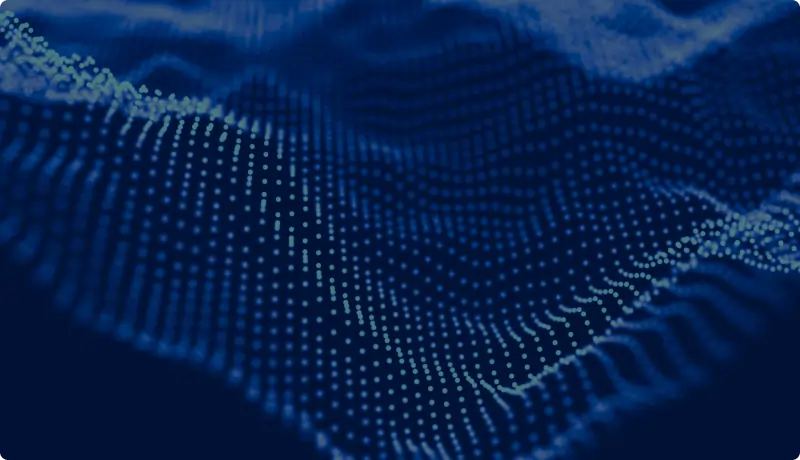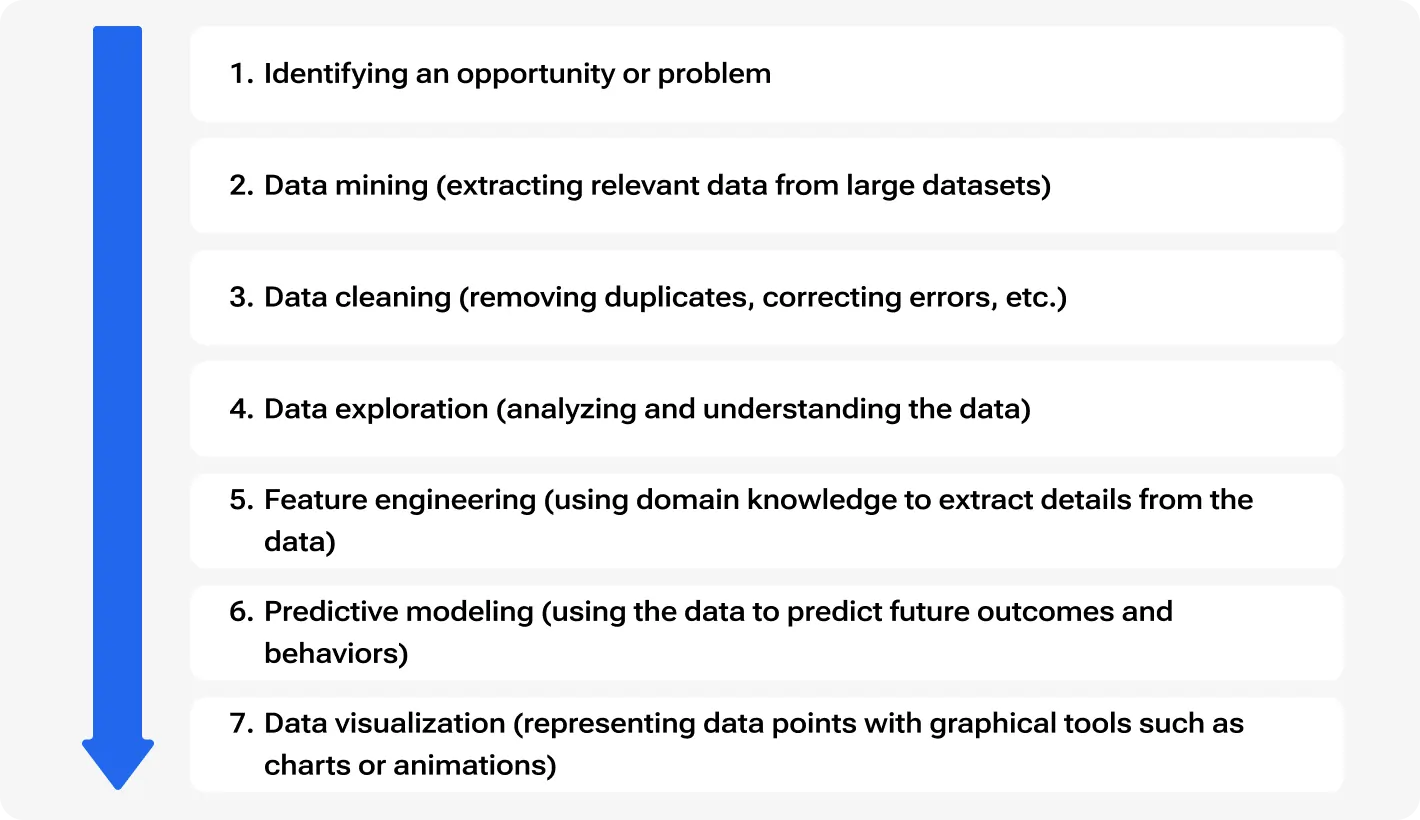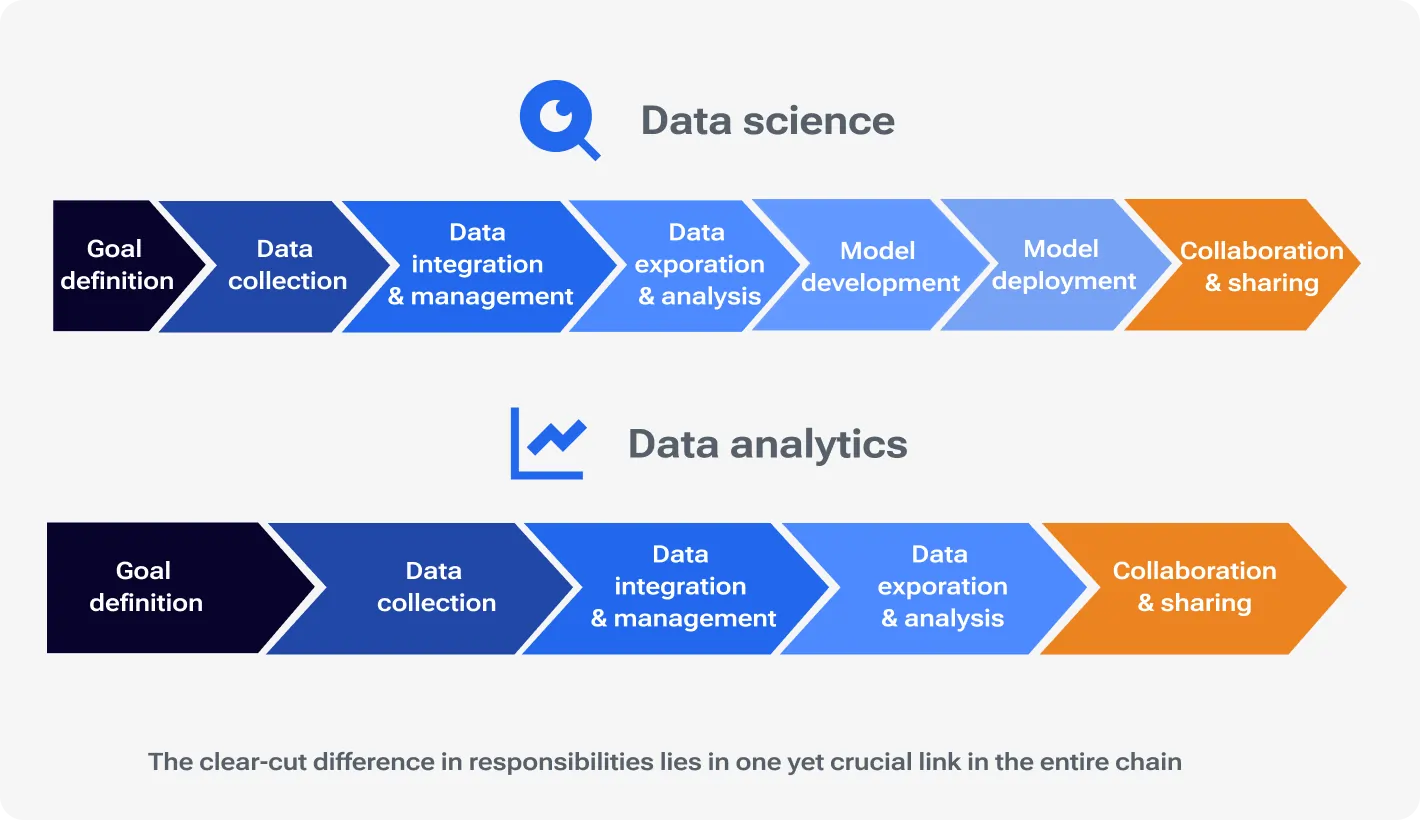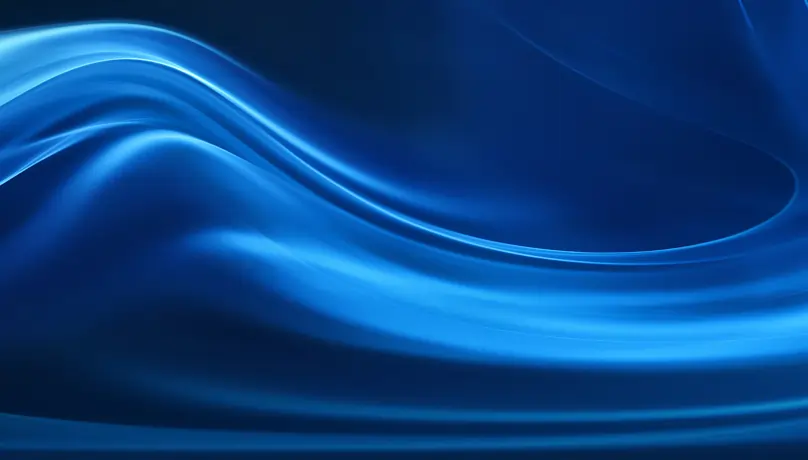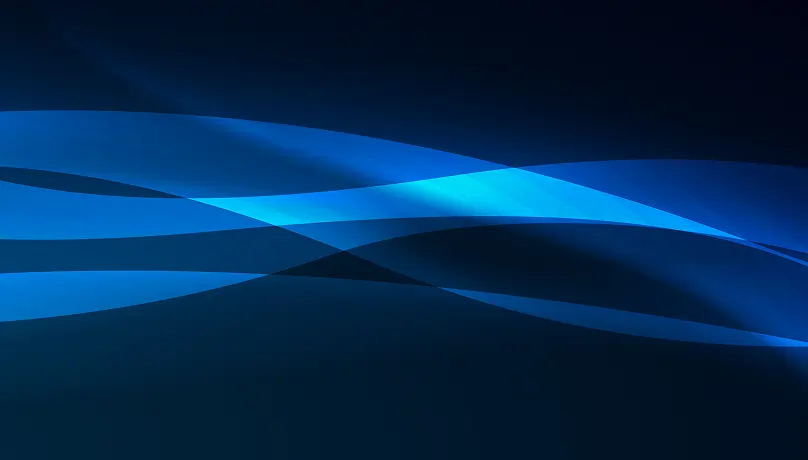Let’s say, you are a restaurant owner. Obviously, you have a chef. And his level of prowess depends on the way he cooks dishes: either strictly following the recipe or trusting the process and experimenting. Data analytics is more like the first option. Data science, on the other hand, is more like experimenting with ingredients to create your own recipes and discover unique flavors.
The most interesting thing is that if anyone wants to become a proficient master chef, they must learn both, since these ways serve different purposes. The same story happens when it comes to working with data.
Lip service? The growing demand for data-driven decision-making backs us up. The Bureau of Labor Statistics is sure data scientists won’t lack job, opportunities showing employment growth of 35% by 2031, much faster than the average for all occupations.
Data science and data analytics are both crucial in compelling data to work, but they are not the same. Data science means a broader scope aimed at the future. It’s about discovering new insights and building data-driven solutions.
Close the gap between data and decision-making with data management to drive innovation up to 75%
In contrast, data analytics focuses on analyzing existing data to answer specific business questions, optimize processes, and support decision-making.
Understanding what is the difference between data science and data analytics helps businesses leverage their data more effectively. If you have found yourself in a situation where you don’t know which approach to use, with these roles you can solve problems more efficiently and innovate in your operations.
What is data science?
Data science is a dynamic field that extracts knowledge and uncovers hidden patterns from vast amounts of data. Typical operations in this case are collecting, analyzing, and interpreting large sets of information. The main goal is to make conscious decisions and predictions.
The overarching goal is to transform raw data into valuable insights that can drive strategic actions.
Let’s turn back to our kitchen comparison — a data scientist is a creative chef who experiments with ingredients to create new recipes. It’s too boring for a creative “chef” to just follow existing recipes. That’s why he explores different combinations and techniques to discover unique flavors for dishes. Similarly, data scientists go beyond analyzing data, they develop new methods and models to extract deeper insights.
Data scientists skill set
Bridging business on data:
Data scientists must have a knack for business development. With this domain expertise, they help define objectives and interpret results effectively.
They bridge the numbers with business-related moves to align insights with organizational goals.
Optimizing data infrastructure:
Efficient data management and optimization. This is essential for data scientists to extract maximum value from all info assets.
Many companies have a hare-brained data infrastructure. One of the data scientists’ goals is to unravel this “data scheme” and ensure seamless data flow and accessibility.
Adequate usage of technical tools and techniques:
Relevance — another keyword for data scientists. They must understand which programming languages, statistical techniques, and software tools are suitable for analyzing and interpreting data.
Their technical expertise enables them to uncover hidden patterns, trends, and insights that drive informed decision-making.
Exploration and communication:
To speak the truth, these are key traits of any successful specialist. But as a data scientist is a cog of data-driven business, curiosity fuels their desire to explore and discover new insights.
Data scientists-aka-chefs are able to spot trends and patterns in data at the right time so that they uncover valuable opportunities for growth and innovation.
They also understand the importance of effective communication and collaboration across an organization.
The difference between data science and data analytics is that the data science pros need a strong foundation in statistics to understand and interpret data, programming skills to manipulate and analyze large datasets, and domain knowledge to apply their findings effectively.
Techniques used in data science
Machine learning: Such pros train algorithms to recognize patterns in data and make predictions. For example, they might develop a model to predict customer churn based on historical behavior.
Artificial intelligence: The main goal of using AI is to enable systems to learn from data and improve over time without being explicitly programmed. This can include natural language processing, image recognition, and more.
Predictive modeling: Here, statistics play the main role. Predictive modeling uses statistical models to forecast future outcomes. For example, predictive models can help businesses forecast sales or identify potential risks.
Data science life chain
Such data moves are iterative, meaning data scientists form hypotheses and experiment to see if a desired outcome can be achieved using available data. These moves are named data science lifecycle, which usually form a 7-link chain:
Brief summary
Data scientists' analytics are looking for insights that are not immediately noticeable. They help businesses understand complex situations and their consequences, identify opportunities, and make data-driven decisions. A typical data management cycle consists of 7 steps. Modern data science employs three top-of-mind techniques: Machine Learning, Artificial Intelligence, and Predictive Modeling.
What is data analytics?
Data analytics is a more narrow discipline than data science. It’s the process of cleaning, analyzing, and interpreting data to answer specific business questions. You can reasonably ask, “are data science and data analytics the same?” Definitely not. Data analytics focuses on making sense of historical data to understand past trends and performance.
On our kitchen metaphor. If data science is like a creative chef developing new recipes, then data analytics is the “check-chef” that examines the recipe meticulously to ensure the dish turns out perfectly every time. It’s about applying established techniques to derive specific insights.
Focus on historical data
One more time, this discipline primarily deals with historical data. Examining past trends allows businesses to gain insights into what has worked and what hasn’t. This retrospective analysis helps organizations make informed decisions, optimize operations, and strategize for the future.
Four main types of data analytics
-
Predictive analytics: Something similar to predictive modeling, you might say. However, predictive analytics seeks to identify trends, correlations, and causation within datasets. The difference here is the basics, the foundation for the prediction. This way, retailers predict which stores are likely to sell out of a product, and healthcare systems forecast regions with rising infection cases.
-
Prescriptive analytics: Prescriptive analytics predicts likely outcomes and provides decision recommendations. An electrical engineer can use it to digitally design and test electrical systems, forecasting energy output and component lifespan.
-
Diagnostic analytics: Pinpoints the reason behind an event. Like when the top striker decided to hit panenka during the UEFA Champions League instead of the typical kick. And we use diagnostic analytics to understand why. Example: Manufacturers can analyze a failed assembly line component to determine the cause of the failure.
-
Descriptive analytics: Descriptive analytics evaluates the quantities and qualities of a dataset. A content streaming provider can use it to understand subscriber gains and losses, as well as popular content.
Common data analytics techniques
Data visualization: This is when the data pro creates visual representations of data, such as charts, graphs, and dashboards. A clear-cut image helps quickly identify patterns, trends, and outliers. An interesting aspect is the use of interactive dashboards, which allow users to explore data dynamically, drilling down into specific details as needed.
Statistical analysis: Typically, these are mathematical techniques for analyzing data and drawing conclusions: mean, median, variance measurements, and standard deviation. A key insight here is the use of hypothesis testing to validate assumptions and make data-driven decisions.
Data mining: Data mining involves exploring large datasets to discover patterns and relationships. In common use, techniques like clustering, classification, and association rule mining. It’s like sifting through a mountain of data to unearth hidden gems. Analysts use specialized algorithms to identify patterns and trends that might not be readily apparent through traditional analysis. This anomaly detection identifies unusual data points that indicate fraud or errors.
Predictive analytics: You may think that this aspect is more related to data science. And it potentially could be. However, if we dive deeper, predictive analytics within data analytics uses historical data to predict future events. Regression analysis and time series forecasting are the most popular techniques. A unique feature is the application of machine learning models to refine predictions continually.
Data warehousing and business intelligence (BI): This is the practice of centrally storing and managing data from various sources. A very rough example is CDP, a customer data platform — a single space that contains all the interactions across all platforms and information about the particular customer. Business intelligence tools then leverage data warehousing to provide interactive dashboards, reports, and analytics that empower business leaders to make data-driven decisions.
Brief summary
Use data visualization, statistical analysis, data mining, predictive analytics, data warehousing, and business intelligence to uncover valuable insights and drive strategic actions. Understanding the role of data analytics will help you to leverage your data more effectively and enhance overall performance.
Key differences between data science and data analytics
To avoid irrelevant skills and techniques adoption and wasting time, it’s crucial to know the difference between these two fields. While both of them are integral to data-driven decision-making, they differ significantly in focus, skill set, methodology, and tools. Here, we break down these key differences to provide a clear understanding of each role.
Focus
Data science. This discipline is more forward-looking. It aims to explore broad, future-oriented questions. Data scientists are visionaries. They find patterns and insights easing predicting future trends and behaviors. They also develop recommendation systems, fraud detection models, and predictive maintenance solutions. All that sounds overwhelming. So, just focus on one thing — if we could equate data scientists to a single question, that’d be "What could happen?".
Data analytics. This field is more retrospective since it focuses on analyzing historical data to answer specific, past-oriented questions. Data analysts’ question would be "What has happened?". Such an outlook allows them to understand performance trends, customer behavior, and operational efficiency. They focus on optimizing business’ current strategies and processes.
Skill set
Data science. Data scientists possess a broader skill set that includes programming, machine learning, and advanced statistical analysis. They are typically proficient in Python and R and use machine learning libraries like TensorFlow and Scikit-learn. Their work often involves creating complex models and algorithms to predict future outcomes.
Data analytics. If we are comparing data science versus data analytics, specialists from the last one excel in data cleaning, manipulation, and communication of insights. Data analysts skilled in using SQL for querying databases, Excel for data manipulation, and data visualization tools like Tableau and Power BI. Their primary goal is to make data accessible and understandable for decision-makers.
Methodology
Data science. The methodology in data science is based on experimentation, model building, and iterative exploration. Their main weapon is hypotheses, which they test through experiments, and refine their models based on the results. This iterative process is crucial for improving model accuracy and reliability.
Data analytics. These pros follow a more defined process with established techniques. Their main weapon is statistical methods to analyze data sets, data mining techniques to uncover patterns, and visualization tools to present their findings. The focus is on providing clear and actionable insights based on past data.
Tools
Data science. Programming languages like Python and R, machine learning libraries such as TensorFlow and Scikit-learn. These tools allow them to build and deploy sophisticated models.
Data analytics. Typically, there are data visualization and business intelligence tools. Tableau, Power BI, and Excel are commonly used to create interactive dashboards and reports. These tools help summarize data and communicate insights effectively to stakeholders.
The power of two: The value proposition of data science and data analytics
Imagine two sides of the same coin: one illustrating past times clearly and the other illuminating the path toward the future. The same with our two fields. Data science vs analytics is not an either/or situation; it's a collaborative approach that unlocks the true potential of your data.
Combining data science and data analytics will allow you to create a comprehensive data-driven strategy. While data analytics focuses on understanding past performance, data science builds upon this foundation to predict future trends and drive innovation.
Data analytics: The foundation
As we already know, data analytics provides the groundwork for data-driven decision-making by analyzing historical data. It helps businesses understand past performance, identify trends, and uncover insights that inform strategic decisions.
For example, analyzing customer purchase histories empowers a retailer to determine which products are in high demand, which marketing campaigns were effective, and which times of year see the highest sales. This foundational understanding allows businesses to optimize inventory management, tailor marketing efforts, and improve customer service strategies.
Data analytics tools, such as Tableau and Power BI, play a crucial role by enabling the visualization of complex data sets, making it easier for business professionals to interpret and act upon the findings.
Data science: Building on analytics
Building on the insights provided by data analytics, data science uses predictive models and machine learning to forecast future trends and behaviors. This forward-looking approach enables businesses to anticipate changes, optimize operations, and innovate. For example, a manufacturer might use data science to predict equipment failures and schedule maintenance, reducing downtime and improving efficiency.
So, are data science and data analytics the same? No. That’s why Amazon leverages both to create a seamless and personalized customer experience. Let’s dive deeper into examples.
Some examples
Amazon. The retail behemoth leverages both data analytics and data science to enhance its operations. Data analytics helps the company understand customer purchasing patterns and optimize inventory. Data science, on the other hand, powers its recommendation engine, predicting products that customers are likely to buy based on their browsing and purchase history. This combination drives sales and improves customer satisfaction.
Walmart. Another giant uses data analytics to monitor and analyze sales data, optimizing inventory levels and pricing strategies. Data science takes this a step further by predicting demand patterns and customer preferences.
Recall the COVID-19 pandemic. At that time, Walmart used predictive models to anticipate spikes in demand for essential items so that they were aware of stock availability and could meet customer needs efficiently. Walmart's use of data science also extends to optimizing supply chain logistics, where machine learning models help forecast demand and streamline the distribution process.
To sum it up
Data science and data analytics are often used interchangeably, but they serve distinct yet complementary roles. Data science focuses on exploring future-oriented questions, building predictive models, and using advanced techniques like machine learning and artificial intelligence.
Conversely, data analytics deals with analyzing historical data to answer specific questions and optimize current operations. The combination of these fields creates a comprehensive data strategy that leverages past performance insights to forecast future trends.
Understanding the differences between data science and data analytics is crucial for businesses aiming to use the full potential of their data. Data analytics lays the foundation by providing a clear understanding of past trends and performance, while data science builds on this foundation to predict and shape future outcomes. This “teamwork” enables businesses to make informed, data-driven decisions that drive growth and innovation.
If you are tech-savvy enough to not pose a question like data science or data analytics, your organization will get a holistic approach to data-driven decision-making. Together, they enhance your ability to understand complex phenomena, anticipate market shifts, and respond proactively. Embracing the strengths of both roles ensures that your business stays competitive and successful in an increasingly data-centric world.
Don't fight for tech talent, get access to data engineers today

